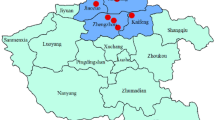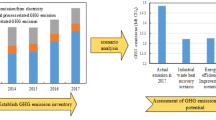Abstract
As an important role in economic development in China, industrial parks have consumed plenty of energy, while emitting enormous air pollutants and discharging large quantities of waste heat. Energy cascade utilization is an effective way to improve the energy efficiency of industrial parks. The objective of this study was to assess the co-benefits of energy cascade utilization, including the energy savings potential, reduction potential of air pollutants, and air quality improvements, in an industrial park in China. Through an energy flow analysis of steam at different pressures and residual gas among various enterprises, this study identified the existing energy cascade utilization network in a baseline scenario and proposed an enhanced scenario. To evaluate the co-benefits of these two scenarios, the CALPUFF model was used to integrate energy savings and air pollutant mitigation for the park in 2017. The results show that energy cascade utilization can result in considerable co-benefits related to energy conservation, air pollutant emission reductions, and air quality improvements. In the enhanced scenario, the total energy savings potential is 11,425 TJ, with emission reductions of 859 tons of SO2 and 910 tons of NOx. Based on the CALPUFF simulations of SO2 and NOx diffusion in the four seasons, the concentrations of SO2 and NOx in the study area considerably decreased in the enhanced scenario compared with those in the baseline scenario. This study demonstrates that the park should focus on the cascade utilization of waste heat and residual gas to improve the energy utilization efficiency and reduce atmospheric pollutant emissions.




Similar content being viewed by others
References
Abdul-Wahab SA, Fgaier H, Elkamel A, Chan K (2015) Air quality assessment for the proposed Miller Braeside quarry expansion in Canada: TSP. Air Qual Atmos Health 8:573–589
ASG (2018) Terrain data is downloaded from website. http://www.src.com/calpuff/data/terrain.html. Assessed 28 August 2018
ASG (The Atospheric Studies Group at TRC) (2018) CALPUFF modeling system from Physicsweb. http://wwwsrccom Assessed 21 October 2018
Chen L, Yang B, Shen X, Xie Z, Sun F (2015) Thermodynamic optimization opportunities for the recovery and utilization of residual energy and heat in China's iron and steel industry: A case study. Appl Therm Eng 86:151–160
Cheng G, Zhang C (2018) Desulfurization and denitrification technologies of Coal-fired flue gas. Pol J Environ Stud 27:481–489
Cheng Y, Zheng G, Wei C, Mu Q, Zheng B, Wang Z, Gao M, Zhang Q, He K, Carmichael G, Poschl U, Su H (2016) Reactive nitrogen chemistry in aerosol water as a source of sulfate during haze events in China. Sci Adv 2:e1601530
Cho H, Smith AD, Mago P (2014) Combined cooling, heating and power: a review of performance improvement and optimization. Appl Energy 136:168–185
Ehrenfeld J, Gertler N (2010) Industrial ecology in practice: the evolution of interdependence at Kalundborg. J Ind Ecol 1(1):67–79
ESA (Department of Economic and Social Affairs) (2013) World economic and social survey 2013, Sustainable Development Challenges. https://sustainabledevelopment.un.org/content/documents/2843WESS2013.pdf Assessed 23 September 2018
Hackl R, Harvey S (2015) From heat integration targets toward implementation - a TSA (total site analysis)-based design approach for heat recovery systems in industrial clusters. Energy 90:163–172
Hao J, Wang L, Shen M, Li L, Hu J (2007) Air quality impacts of power plant emissions in Beijing. Environ Pollut 147:401–408
Huang F, Zheng J, Baleynaud JM, Lu J (2017) Heat recovery potentials and technologies in industrial zones. J Energy Inst 90:951–961
Jin H, Gao L, Han W, Li B, Feng Z (2007) Integrated energy systems based on cascade utilization of energy. Front Energy Power Eng Chin 1:16–31
Jouhara H, Khordehgah N, Almahmoud S, Delpech B, Chauhan A, Tassou SA (2018) Waste heat recovery technologies and applications. Therm Sci Eng Prog 6:268–289
Kim H, Dong L, Choi AES, Fujii M, Fujita T, Park H (2018) Co-benefit potential of industrial and urban symbiosis using waste heat from industrial park in Ulsan, Korea. Resour Conserv Recycl 135:225–234
Klimont Z, Kupiainen K, Heyes C, Purohit P, Cofala J, Rafaj P, Borken-Kleefeld J, Schöpp W (2017) Global anthropogenic emissions of particulate matter including black carbon. Atmos Chem Phys 17:8681–8723
Li W, Cui Z, Han F (2015) Methods for assessing the energy-saving efficiency of industrial symbiosis in industrial parks. Environ Sci Pollut Res 22(1):275–285
Liu Y, Yang J, Wang J, Cheng Z, Wang Q (2014) Energy and exergy analysis for waste heat cascade utilization in sinter cooling bed. Energy 67:370–380
Liu F, Zhang Q, Tong D, Zheng B, Li M, Huo H, He KB (2015) High-resolution inventory of technologies, activities, and emissions of coal-fired power plants in China from 1990 to 2010. Atmos Chem Phys 15:13299–13317
Lu HY (2015) Capturing the invisible resource: analysis of waste heat potential in Chinese industry and policy options for waste heat to power generation. https://eta.lbl.gov/sites/all/files/publications/lbnl-179618.pdf. Assessed 9 October 2018
Lu Z, Streets DG, Zhang Q, Wang S, Carmichael GR, Cheng YF, Wei C, Chin M, Diehl T, Tan Q (2010) Sulfur dioxide emissions in China and sulfur trends in East Asia since 2000. Atmos Chem Phys 10:6311–6331
Ma G, Cai J, Zeng W, Dong H (2012) Analytical research on waste heat recovery and utilization of China’s iron & steel industry. Energy Procedia 14:1022–1028
McKenna RC, Norman JB (2010) Spatial modelling of industrial heat loads and recovery potentials in the UK. Energy Policy 38:5878–5891
MEP (2011) The industrial pollution source and discharge coefficient manual of the first national pollution source survey, Non-ferrous metal smelting and rolling processing industry 8:139
MEP (Ministry of Environmental Protection of China) (2012) Ambient air quality standards. GB:3095–2012
Pretorius I, Piketh S, Burger R (2017) Emissions management and health exposure: should all power stations be treated equal? Air Qual Atmos Health 10:509–520
Ravina M, Panepinto D, Zanetti MC, Genon G (2017) Environmental analysis of a potential district heating network powered by a large-scale cogeneration plant. Environ Sci Pollut Res 24:13424–13436
Skamarock WC, Klemp J, Dudhia J, Gill DO, Barker D, Wang W, Powers JG (2008) A description of the advanced research WRF version 3, 27, 3-27, https://www.researchgate.net/publication/306154004 assessed 14 August 2018
Song HC, Sang HK, Yoon SG, Park S (2010) Optimization of a waste heat utilization network in an eco-industrial park. Appl Energy 87(6):1978–1988
Tian WY, Zhang JY, Dai CD, Long XY (2015) Recovery of waste heat from sinter cooling process: simulation and optimisation. Ironmak Steelmak 42:97–104
US EPA (2003) Air pollution control technology fact sheet. https://www3.epa.gov/ttnchie1/mkb/documents/fcondnse. pdf. Assessed 13 February 2019
US EPA (Environmental Protection Agency) (1995) complication of air pollutant emission factors, AP-42. https://www.epa.gov/air-emissions-factors-and-quantification/ap-42-compilation-air-emissions-factors. Assessed 5 Apr 2019
Wen Z, Xu J, Lee JCK, Ren C (2017) Symbiotic technology-based potential for energy saving: a case study in China’s iron and steel industrial parks. Renew Sust Energ Rev 69:1303–1311
Yang H (2016) Waste heat recycling utilization of pot fume. Light Met 07:60–62 (in Chinese)
Zhang Q, Streets DG, Carmichael GR, He KB, Huo H, Kannari A, Klimont Z, Park IS, Reddy S, Fu JS, Chen D, Duan L, Lei Y, Wang LT, Yao ZL (2009) Asian emissions in 2006 for the NASA INTEX-B mission. Atmos Chem Phys 9:5131–5153. https://doi.org/10.5194/acp-9-5131-2009
Zhang H, Dong L, Li HQ, Chen B, Tang Q, Fujita T (2013) Investigation of the residual heat recovery and carbon emission mitigation potential in a Chinese steelmaking plant: a hybrid material/energy flow analysis case study. J Renew Sustain Energy 2(1):67–80
Zhang S, Worrell E, Crijns-Graus W, Wagner F, Cofala J (2014) Co-benefits of energy efficiency improvement and air pollution abatement in the Chinese iron and steel industry. Energy 78:333–345
Zheng B, Huo H, Zhang Q, Yao ZL, Wang XT, Yang XF, Liu H, He KB (2014) High-resolution mapping of vehicle emissions in China in 2008. Atmos Chem Phys 14:9787–9805
Funding
This study was supported by the Energy Foundation for Evaluation and Upgrading Scheme of Circular and Low-carbon Industrial Park in Henan Province: A case study of Yongcheng Economic and Technological Development Zone (G-1709-26857).
Author information
Authors and Affiliations
Corresponding author
Additional information
Responsible editor: Philippe Garrigues
Publisher’s note
Springer Nature remains neutral with regard to jurisdictional claims in published maps and institutional affiliations.
Highlights
• Energy cascade utilization chains in a complex industrial park are analyzed.
• Steams of different pressures (high- to low-pressure steams, 9.8 to 0.4 MPa) and residual gas are used for energy recovery among different industries.
• The CALPUFF model is used to simulate the concentrations of air pollutants under different energy utilization scenarios in an industrial park.
Electronic supplementary material
ESM 1
(DOCX 3111 kb)
Rights and permissions
About this article
Cite this article
Ma, Y., Wang, S., Wang, K. et al. Co-benefits analysis of energy cascade utilization in an industrial park in China. Environ Sci Pollut Res 26, 16181–16194 (2019). https://doi.org/10.1007/s11356-019-04932-6
Received:
Accepted:
Published:
Issue Date:
DOI: https://doi.org/10.1007/s11356-019-04932-6




